
Michelangelo Merisida Caravaggio, known as simply Caravaggio, was an Italian painter active in Rome for most of his artistic life. During the final four years of his life he moved between Naples, Malta, and Sicily until his death. His paintings have been characterized by art critics as combining a realistic observation of the human state, both physical and emotional, with a dramatic use of lighting, which had a formative influence on Baroque painting.
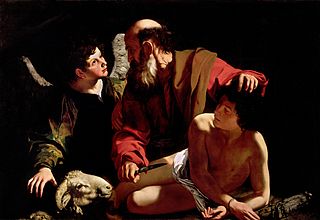
The Sacrifice of Isaac is the title of two paintings from c. 1598 - 1603 depicting the sacrifice of Isaac. The paintings could be painted by the Italian master Caravaggio (1571–1610) but there is also strong evidence that they may have been the work of Bartolomeo Cavarozzi, a talented early member of the Caravaggio following who is known to have been in Spain about 1617–1619.
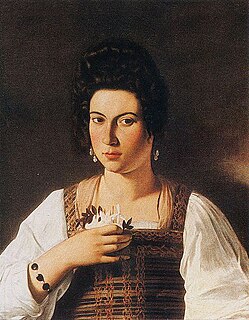
Portrait of a Courtesan was a painting by the Baroque master Michelangelo Merisi da Caravaggio. Painted between 1597 and 1599, it was destroyed in Berlin in 1945 and is known only from photographs. It has been suggested that the portrait represents the goddess Flora.
John the Baptist was the subject of at least eight paintings by the Italian Baroque artist Michelangelo Merisi da Caravaggio (1571–1610).

David and Goliath is a painting by the Italian Baroque master Caravaggio (1571–1610). It was painted in about 1599, and is held in the Museo del Prado, Madrid. Two later versions of the same theme are currently to be seen in Kunsthistorisches Museum, Vienna, and in Rome's Galleria Borghese.

Ecce Homo is a painting by the Italian Baroque master Caravaggio. It is housed in the Palazzo Bianco, Genoa. Contemporary accounts claim the piece was part of a unannounced competition between three artists, and that the Caravaggio version was eventually sent to Spain.

Saint Francis in Prayer is a painting from the Italian master Caravaggio, in the Galleria Nazionale d'Arte Antica in Rome.
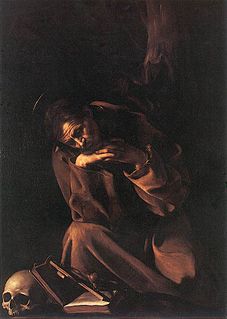
Saint Francis in Meditation, is a painting by the Italian master Caravaggio, in the Museo Civico, Cremona.
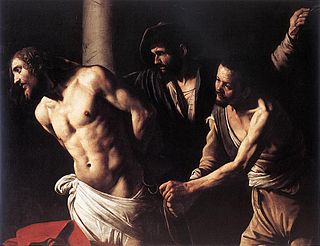
Christ at the Column, is a painting by the Italian Baroque painter Caravaggio, now in the Musée des Beaux-Arts de Rouen, Rouen, France.

David with the Head of Goliath, c. 1607, in the Kunsthistorisches Museum Gemäldegalerie, Vienna, is a painting by the Italian artist Caravaggio (1571–1610). Peter Robb believes it to have been acquired by the conde de Villamediana in Naples between 1611 and 1617, as Giovanni Bellori records Villamediana as having returned to Spain with a half-figure of David by Caravaggio.
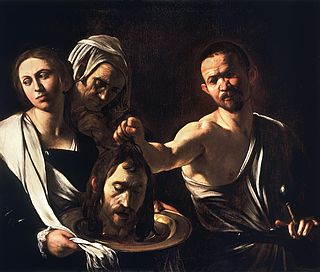
Salome with the Head of John the Baptist (London), c. 1607/1610, is a painting by the Italian master Caravaggio now in the collection of the National Gallery in London.
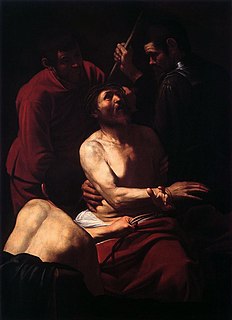
The Crowning with Thorns was the subject of two paintings by the Italian master Caravaggio. The first version, dated to around 1604–1605, is now in the Cassa di Risparmi e Depositi of Palazzo degli Alberti, Prato (Tuscany). The attribution to Caravaggio is disputed.

Portrait of Alof de Wignacourt with his Page is a painting by the Italian master Caravaggio, in the Louvre of Paris.

The Annunciation is an oil painting by the Italian master Michelangelo Merisi da Caravaggio, finished around 1608. It housed in the Musée des Beaux-Arts de Nancy.
A number of paintings have been attributed from time to time to the Italian artist Michelangelo Merisi da Caravaggio (1571–1610), but are no longer generally accepted as genuine. Immensely popular in his own lifetime, he fell into neglect almost immediately upon his death, with the result that now, four hundred years later, it is often extremely difficult to distinguish works by the master from copies or from original creations by his most gifted followers.

Bartolomeo Manfredi was an Italian painter, a leading member of the Caravaggisti of the early 17th century.

The beheading of John the Baptist, also known as the decollation of Saint John the Baptist or the beheading of the Forerunner, is a biblical event commemorated as a holy day by various Christian churches. According to the New Testament, Herod Antipas, ruler of Galilee under the Roman Empire, had imprisoned John the Baptist because he had publicly reproved Herod for divorcing his first wife and unlawfully taking his sister-in-law as his second wife Herodias. He then ordered him to be killed by beheading.

The Beheading of Saint John the Baptist is an oil painting by the Italian artist Caravaggio. Measuring 3.7 m by 5.2 m, it depicts the execution of John the Baptist. It is located in the Oratory of St. John's Co-Cathedral in Valletta, Malta.
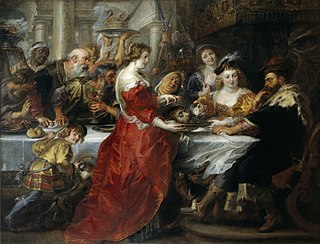
The Feast of Herod refers to the episode in the Gospels following the Beheading of St. John the Baptist, when Salome presents his head to her parents. The account in the Book of Mark describes Herod holding a banquet on his birthday for his high officials and military commanders, and leading men of Galilee. At this banquet, Herod's daughter dances before Herod, who is pleased and offers her anything she asks for in return. The girl asks her mother what she should request, and she is told to demand the head of John the Baptist. Reluctantly, Herod orders the beheading of John, and John's head is delivered to her, at her request, "on a platter."(Mark 6:17–29)
Salome with the Head of John the Baptist may refer to:
















